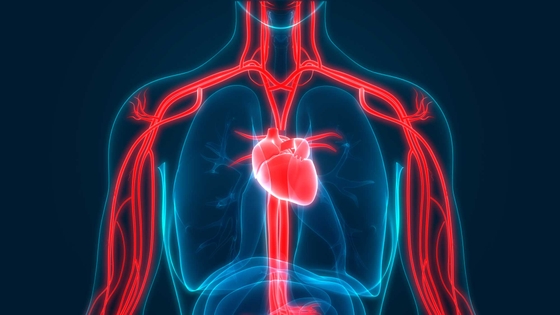.jpg?format=pjpg&auto=webp)
What is atrial fibrillation?
Atrial fibrillation is a type of arrhythmia where your heart beats irregularly and fast.
Key takeaways
2 min read
Atrial fibrillation (AF or Afib) is a type of arrhythmia in which your heart beats irregularly and often fast.
This reduces your heart’s ability to pump blood properly and increases the chance of a blood clot forming in your heart and travelling up to your brain, where it can cause a stroke.
The common symptoms of atrial fibrillation include: feeling breathless, feeling faint, dizzy or lightheaded, racing heart (palpitations), tiredness or weakness, chest discomfort and difficulty exercising.
The heart has its own electrical system. In a healthy heart, regular electrical signals cause your heart to pump blood in a steady rhythm of 60 to 100 beats per minute. This is known as your heartbeat.
With a normal heartbeat, your heart can effectively pump blood to the rest of your body. Arrhythmia is a fault in the heart’s electrical system that affects its pumping rhythm. This causes your heart to beat too fast, too slowly or irregularly.
What is atrial fibrillation?
Atrial fibrillation (also called AF or Afib) is a type of arrhythmia. In atrial fibrillation, abnormal electrical activity in the top chambers of the heart overwhelms the heart’s own pacemaker (part of its electrical system) and the conduction messages become chaotic.
This causes the heart’s top two chambers (atria) to twitch rather than contract. The atria twitch rapidly and out of rhythm with the heart’s lower two chambers (ventricles).
As a result, your heart beats in a fast and irregular way. This reduces your heart’s ability to pump blood properly. It also increases the chance of blood clots forming in your heart and travelling up to your brain, where it can cause a stroke. Atrial fibrillation is not usually life-threatening when it's properly treated.
What does atrial fibrillation feel like?
The symptoms of atrial fibrillation are different for everyone. Some people experience daily symptoms. Other people experience no symptoms at all.
Common symptoms of atrial fibrillation include:
Feeling breathless
Feeling faint, dizzy or lightheaded
Racing heart (palpitations)
Tiredness or weakness
Chest pain or discomfort
Difficulty exercising
What are the three types of atrial fibrillation?
Paroxysmal atrial fibrillation
This type of atrial fibrillation starts and stops suddenly. Episodes can last for seconds, minutes, hours or up to a week. Episodes stop without treatment.
Persistent atrial fibrillation
This type of atrial fibrillation has episodes that last longer than a week. Medications or ‘electrical shock’ treatment are needed to get the heart back into normal rhythm to stop the episode.
Permanent atrial fibrillation
This type of atrial fibrillation continues long term (longer than one year). The heart doesn’t return to a normal rhythm and medications may be used to help control symptoms.
Atrial fibrillation is a progressive disease. This means that it gets worse over time. As a result, paroxysmal atrial fibrillation can develop into persistent or permanent atrial fibrillation.
What is atrial flutter?
Atrial flutter is a type of arrhythmia where the atria of your heart beats too quickly. This causes a fast, regular heart rhythm. Although similar to atrial fibrillation, atrial flutter is characterised by a more regular and less chaotic heart rhythm.
The risk factors, causes, and symptoms of atrial flutter and atrial fibrillation are similar. Like atrial fibrillation, atrial flutter is not usually life-threatening when it's properly treated. Sometimes atrial flutter can develop into atrial fibrillation and vice versa.
What causes atrial fibrillation?
Having atrial fibrillation increases your risk of complications, including having a stroke or developing heart failure. Both of these are serious conditions. It’s good to know that by maintaining a healthy lifestyle and managing your medical conditions, you can reduce your risk of developing atrial fibrillation.
The causes of atrial fibrillation are not always clear. Certain medical conditions are known to cause atrial fibrillation. Other medical conditions and lifestyle factors are known to increase your risk of developing atrial fibrillation. These causes and risk factors include:
Age – The risk of developing atrial fibrillation increases with age.
Heart diseases and events – Including heart attack, heart failure, heart valve disease, coronary heart disease, and congenital heart disease.
High blood pressure
Other medical conditions – Certain medical conditions such as infections, thyroid problems, obstructive sleep apnoea, metabolic syndrome, diabetes, chronic kidney disease and lung disease have an increased risk of atrial fibrillation.
Surgery – Some surgeries can cause atrial fibrillation. Your doctor will discuss this risk with you when making decisions for surgery.
Drinking alcohol – Drinking alcohol can increase your risk of developing atrial fibrillation. For some people already diagnosed with atrial fibrillation, alcohol can trigger an episode of atrial fibrillation. Binge drinking may put you at an even higher risk.
Obesity – People who are obese are at a higher risk of developing atrial fibrillation.
Family history – Some families have an increased genetic risk of developing atrial fibrillation.
Atrial fibrillation can also occur in people with no other known medical conditions. This is called lone atrial fibrillation. Learn more about risk factors for heart disease.
Common atrial fibrillation triggers
People who have paroxysmal atrial fibrillation may find there are certain things that trigger an atrial fibrillation episode, such as:
Alcohol
Stress and anxiety
Caffeine
Exercise
Fatigue and lack of sleep
Infection
Certain medications
Smoking
Dehydration
Can you prevent atrial fibrillation?
You can lower your risk of developing atrial fibrillation by:
Maintaining a healthy weight
Managing your blood pressure
Managing diabetes (if you have been diagnosed with diabetes)
Quitting smoking
Being physically active
Reducing alcohol intake to less than or equal to three standard drinks a week.
What is the risk of stroke with atrial fibrillation?
Atrial fibrillation is a major cause of stroke in Australia. People with atrial fibrillation are five times more likely to have a stroke than those without. This is because atrial fibrillation reduces your heart’s ability to pump blood properly. This increases the chance of blood pooling in the heart and forming clots. If these clots travel up to your brain, they can cause a stroke. It’s good to know that there are a number of ways to reduce your risk of stroke by working with your doctor. Your doctor will regularly assess your risk of stroke and may prescribe blood thinning medications (anti-coagulants) or discuss other options available to you. Blood thinning medications greatly reduce the risk of stroke. Always follow your doctor’s instructions about which is the best treatment for you. If you’re living with atrial fibrillation it’s important to know the warning signs of a stroke and the importance of seeking help early.What is the risk of heart failure with atrial fibrillation?
Very fast or uncontrolled atrial fibrillation can weaken your heart over time, eventually causing heart failure. This is a condition where the heart is unable to pump blood around the body properly. Atrial fibrillation is also very common if you already have heart failure.
How is atrial fibrillation diagnosed?
To diagnose atrial fibrillation, your doctor will review your signs and symptoms and conduct a physical examination. They may order the following diagnostic tests:
Blood test – This helps rule out thyroid problems or other things in your blood that could cause atrial fibrillation.
Chest X-ray – These images help your doctor see your lungs and heart to rule out atrial fibrillation.
Echocardiogram – This test creates moving pictures of your heart. It may diagnose structural heart disease or blood clots in your heart.
Electrocardiogram (ECG) – This test is the main tool for diagnosing atrial fibrillation. It measures your heart’s electrical signals.
Event recorder – This is a portable ECG. It records your heart's activity over weeks to months.
Holter monitor – This is a portable ECG. It records your heart's activity for 24 hours or longer.
Implantable loop recorder – This may be implanted under your skin in the chest area to continually record your heart's electrical activity and detect abnormal heart rhythms.
Stress test (exercise testing) – This test is performed by your doctor during exercise.
What is the treatment for atrial fibrillation?
It’s important to treat atrial fibrillation to manage its symptoms and prevent a stroke. The treatment for atrial fibrillation differs between people, depending on your symptoms, the underlying cause, and any other health conditions.
Usually, atrial fibrillation can be well managed by your doctor with:
Medication – Regular medication can be given to normalise the heart’s rhythm (anti-arrhythmic agents) or slow the heart rate (beta-blockers, some calcium channel blockers and digoxin). Blood thinning (anticoagulation) medications may also be prescribed.
Electrical cardioversion – An electrical shock to the chest done under general anaesthesia to restore the heart’s normal electrical rhythm.
Pharmacological cardioversion – Medication to restore the heart’s normal electrical rhythm in a short period of time.
Catheter ablation – A procedure performed in hospital using a catheter to destroy (ablate) the area inside the heart that’s causing the abnormal rhythm. If your doctor recommends an ablation, they will discuss the benefits and risks with you.
Pacemaker – A small implantable device that electrically stimulates the heart to maintain a regular heart rhythm.
Lifestyle changes – Stopping drinking and smoking will reduce the burden of atrial fibrillation on your life.
Weight loss (if overweight)
Management of other medical conditions – Including high blood pressure, heart failure, heart valve disease and diabetes.
Obstrustive sleep apnoea management
Avoiding triggers (where possible)
Exercise
Should you exercise if you have atrial fibrillation?
When you're first diagnosed, you may be worried that exercise might trigger an episode or make your condition worse. In fact, exercise is very important for your ongoing health and wellbeing.
Regular exercise has many heart health benefits, including:
Reduced risk of stroke
Reduced atrial fibrillation symptoms
Lowered resting heart rate over time
Reduced risk of other heart diseases
Weight management
Improved mood and sense of wellbeing.
Living with atrial fibrillation
Receiving an atrial fibrillation diagnosis can be scary and frightening. But you’re not alone. Around half a million Australians are currently living with atrial fibrillation. Medical treatment, exercise and cardiac rehabilitation classes (exercise plan) will allow you to manage your symptoms and improve your quality of life.
It’s important that you see your doctor regularly to review your heart health, medications, risk of stroke and lifestyle. Taking your medications every day is vital to manage your atrial fibrillation. Talk to your doctor, pharmacist or nurse if you have any questions about your treatment plan or medicines.
The good news is that although atrial fibrillation is a long-term condition, if managed correctly, you can continue to lead a long and active life.
References
- Australian Institute of Health and Welfare. Heart, stroke and vascular disease: Australian facts. Accessed 14th Feburary, 2024. https://www.aihw.gov.au/reports/heart-stroke-vascular-disease/hsvd-facts/contents/all-heart-stroke-and-vascular-disease/atrial-fibrillation
- Brundel B, Ai X, Hills MT, Kuipers MF, Lip GYH, de Groot NMS. Atrial fibrillation. Nat Rev Dis Primers. Apr 7 2022;8(1):21. doi:10.1038/s41572-022-00347-9
- Gutierrez C, Blanchard DG. Diagnosis and Treatment of Atrial Fibrillation. Am Fam Physician. Sep 15 2016;94(6):442-52.
You might also be interested in...

Atrial fibrillation information for patients
Patient-centred care is recognised as one of the fundamental aspects of integrated care in the guidelines for atrial fibrillation (AF).

Atrial fibrillation clinical resources for healthcare professionals
Developed using current evidence from the Australian Clinical Guidelines for the Diagnosis and Management of Atrial Fibrillation (2018).
.jpg?width=560&height=auto&format=pjpg&auto=webp)
What is an arrhythmia?
Explore the different types of arrhythmia, including tachycardia, bradycardia, and irregular heartbeats. Learn about symptoms, causes, and treatment options.
Last updated09 April 2025
| Last reviewed08 February 2024